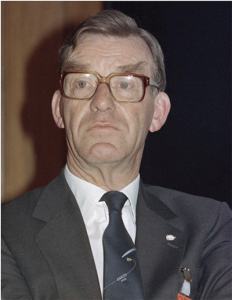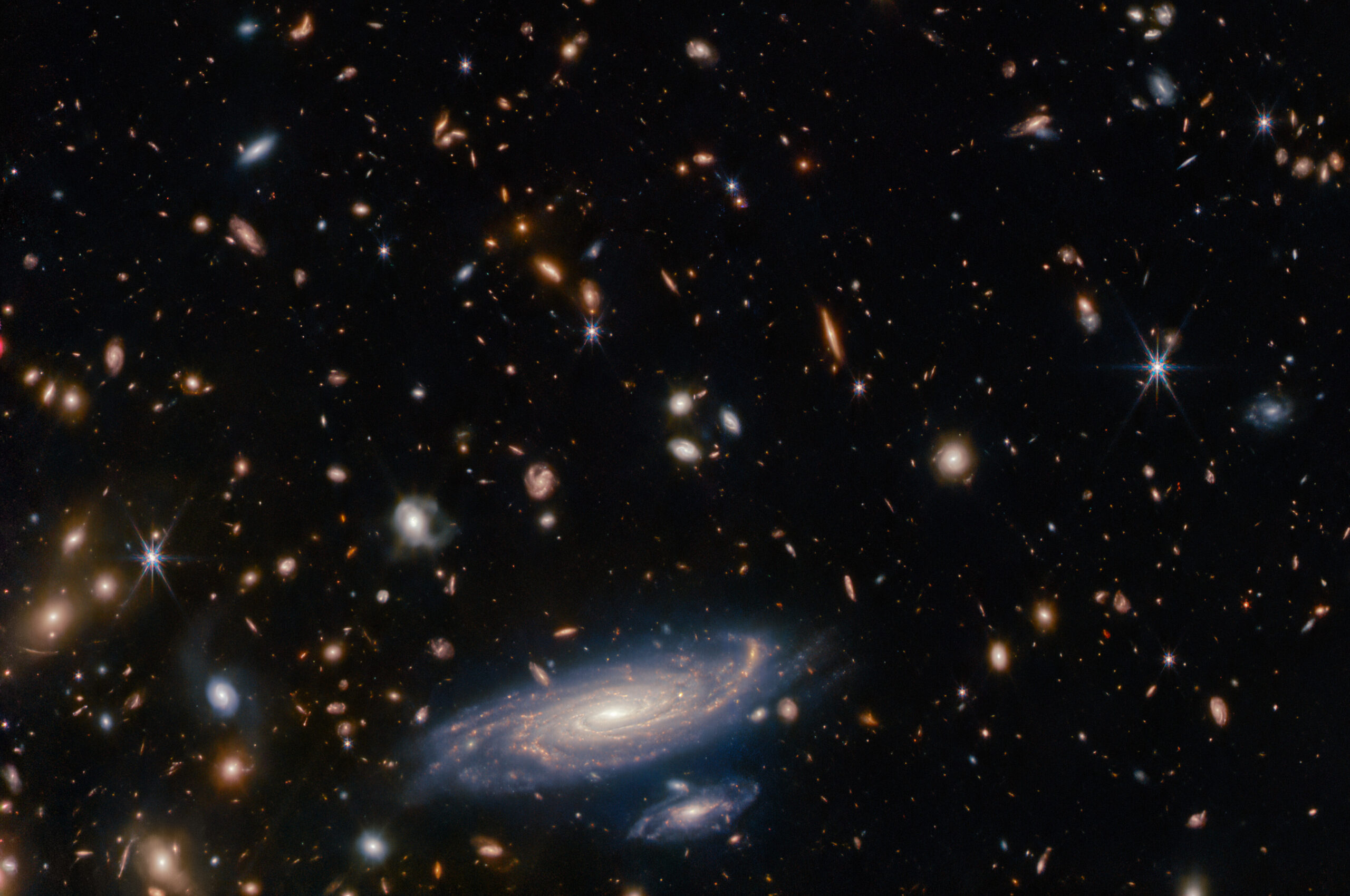
Reimar Lüst (Image Credit: Kurt Strumpf/AP)
Reimar Lüst, of German nationality, astrophysicist, and well known for his work on cosmic rays, plasma physics, hydrodynamics and nuclear fusion, and a pioneer of European space research, passed away during the night of 31st March, in Hamburg where he lived, one week after his 97th birthday. He was the son of a Lutheran Pastor and born into a pious household in the town of Wuppertal-Barmen on 25 March 1923. He attended school in the Kessel gymnasium from 1933 until 1941 when he had to rejoin the Kriegsmarine in the cold water of the Bay of Biscay, serving as a submarine officer. His U-boat N° 528 was severely damaged, bombed and destroyed by a British depth-charge and was going to be sunk to prevent it from getting into the hands of the enemy, drowning eleven men on board. From a depth of 320 m, thanks to his physical strength and some luck, he was able to make it up to the sea surface and then swam for several hours to an English frigate which had attacked the U-boat, before being heaved onto the deck and sent as a prisoner-of-war in a camp, first in England and then in the US at Mexia, Texas, where he stayed until 1945. This was long enough for him to be appreciated by his guards for his mathematical talents, solving calculus problems on toilet paper. That is how he started his brilliant and extraordinary career.
In 1946, he returns to destroyed Germany and is a student at the Johann-Wolfgang-Goethe Frankfurt University where he gets a Diploma in 1949, and in 1951 he becomes assistant of Carl Friedrich von Weizsäcker, brother of the future President of Germany, and Werner Heisenberg (Nobel Prize, 1932) of the Physics Max Planck Institute in Göttingen where he gets his doctorate in theoretical physics under the direction of his two prestigious professors. He then worked in theoretical plasma physics and astrophysics for the next ten years. In 1955, he gets a Fulbright fellowship and rejoins the United States and the Institute Enrico Fermi at the Universities of Chicago and then Princeton, where he worked with John Simpson, Eugene Parker, and James van Allen in Iowa.
In 1956, he becomes the father of Dieter Lüst, well known physicist and cosmologist, presently Director of the Max Planck Institute of physics created by Heisenberg in 1958. He obtains his habilitation in physics in 1959 at the University of Munich, and in the same year his wife gives birth to his second son Martin, Nokia Head of Technology. He then spent several years in the USA as visiting professor at New York University (1959), Massachusetts Institute of Technology (1961) and Caltech (1962). In 1964, he becomes Professor at the University of Munich.
In 1960, following a suggestion of one of his early collaborators, Ludwig Biermann, he realized the potential of space research for astrophysics and Earth sciences. Biermann proposed to directly probe the just-discovered solar wind, using alkali metals ionized by solar radiation creating an “artificial comet” which would then trace the magnetic field carried by the solar wind, and reveal its structure and behavior into interplanetary space, as they would become visible in optical wavelengths and therefore observable from the ground. In 1961, he is committed by the Max Plank Society to leading a working group in charge of founding what would be the future national space program of Germany. Two years later he founds the Max-Planck Institute for extraterrestrial Physics (MPE) in Garching and started developing rocket experiments together with Gerhard Haerendel.
In the post-war context, the development of rockets in Germany was a delicate and sensitive idea. Looking for a possible cooperation with scientists from the war allies, Lüst became a frequent visitor of space science meetings and was able to attract the attention of COSPAR participants, in particular Jacques Blamont, Director of the Service d’Aéronomie near Paris whose program was the study of the Earth upper atmosphere and of the Sun. With Blamont, he developed a true friendship which allowed him to launch from the Ile du Levant in the south of France and from Hammaguir in the Algerian desert, between 1962 and 1966, a series of sounding rockets of the French outfit, including the Centaure and the Véronique (French version of the V2). Both him and Gerhard Haerendel could then test the idea of Ludwig Biermann and were the first to send barium clouds in the upper atmosphere and measure the extension and dynamics of the Earth magnetic field. In the post-war context these experiments would not have been possible without the French hospitality and Lüst’s intelligence, and the attraction he exerted on his colleagues.
These years determined Lüst future involvement in the European space program and opened the door to the future involvement of Europe in space science. In 1962, he becomes the President of the European Preparatory Commission for SpaceResearch(COPERS), which gave birth to the European Space Research Organization, ESRO (the ancestor of ESA), founded by Pierre Auger and Eduardo Amaldi, the fathers of CERN.
In 1972, he became the youngest President in the history of the Max Planck Society, at a time of social and political upheaval. Nevertheless, Reimar Lüst succeeded in mastering these challenges with sustained effect. In 1984, the ESA Council, chaired by French physicist Hubert Curien, assigned him the responsibility of General Director, a position he will leave in 1990. As early as 1985, at the ESA Council of minister in Rome, he was responsible for presenting and managing the initiation of major successful decisions, which his successors and the whole European space community are still benefit from: Ariane 5, Europe’s participation to the future International Space Station, and the Horizon 2000 long-term plan which elevated ESA to the second rank of all scientific space agencies in the world. Many of the structures and instruments introduced by him during his term of office still characterize ESA to this day.
In 1990, still at ESA, he started discussions with his friend Johannes Geiss to develop an International Space Science Institute (ISSI) and convinced of the genuine value and originality of that concept, took the seminal decision to finance ISSI from ESA’s space science budget, under the conditions that the Institute should be directed by a prominent scientist of interdisciplinary international reputation, and that it should be attached to the Inter-Agency Consultative Group (IACG), which was created in 1982 to coordinate the science missions planned by ESA, USSR, Japan and NASA, to Halley’s comet at its 1986 return to perihelium. This condition is still in effect today, materialized by the presence of representatives of these four agencies in the ISSI Board of Trustees.
Between 1989 and 1999, he becomes president of the Foundation Alexander von Humboldt and under the initiative of the Bremen City, he founds the Jacobs University Bremen (IUB), which, as chairman of the board, he shaped towards excellence.
Reimar Lüst has been one of the most versatile drivers of German and European science policy. His numerous responsibilities led him to meet several heads of States and Governments. He and his wife Nina Grunenberg, Die Zeit journalist, became very close friends of Chancellor Helmut Schmidt. He was a great friend of France and was awarded by Hubert Curien the distinction of Officer de la Légion d’Honneur, one among many others such as the Order of Merit of the Federal Republic of Germany. All those who have met him during his long and extraordinary career will never forget this great scientist, great manager of big institutions, certainly very demanding and very efficient, of immense political talent, and totally faithful in his friendships.
Roger-Maurice Bonnet, International Space Science Institute
